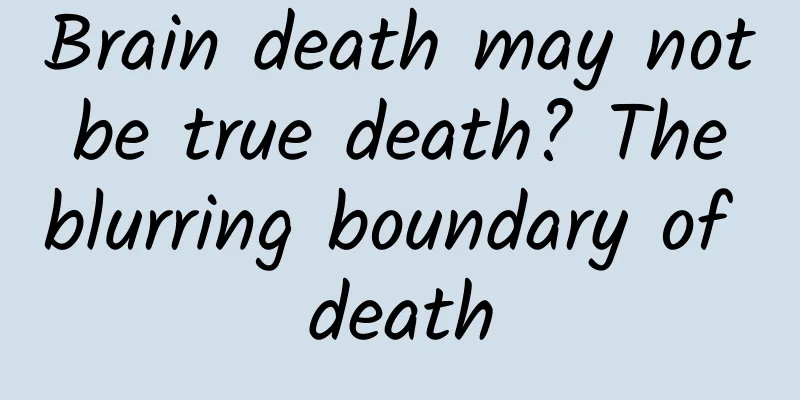Brain death may not be true death? The blurring boundary of death

|
Author: Global Science Mechanisms for coping with death may be unique to humans We don’t see animals taking death so seriously except humans. Although chimpanzees, dogs, cats, or bees may express mourning behaviors for their dead offspring or companions, there is no solid evidence that they have enough self-awareness to realize that they will die one day. Therefore, it is likely that humans have only evolved mechanisms to cope with death in the last 10 million years. More than 2,000 years ago, Aristotle wrote in his Treatise on the Soul that any living organism is more than just the sum of its visible parts (organs). He proposed that plants, animals, and humans all have a "plant soul," which is also an essential part of life. In Aristotle's thought, in addition to the plant soul, he proposed that there are two other parts of the soul, namely the sensual soul and the rational soul. The plant soul can support the body's necessary functions such as nutrition, growth and reproduction. When these basic functions are lost, life gradually disappears. The sensual soul enables animals or humans to perceive the world or themselves, while the rational soul is only possessed by humans, which enables people to reason, dialogue and speak. But many questions remain: How can we precisely isolate a living organism from the space and time around it? Are clothes, dental implants or contact lenses part of the body? When does life begin and when does it end? For most of human history, determining death was a simple process. Doctors could declare a patient dead simply after a few minutes of no heart rate, no breathing, or no response to light in the eyes (indications of brain function). So the timeline of death was clear. In the mid-twentieth century, everything changed with the advent of ventilators, mechanical ventilation, CPR and pacemakers, which meant that a person whose heart stopped beating or whose lungs stopped breathing could continue to survive. Today's intensive care system allows a person to maintain heart and lung function without relying entirely on brain control. These technologies, along with improved methods of measuring brain function, led to the formation of a committee at Harvard University in 1968. The committee members developed a then-controversial definition of irreversible coma or brain death, a neurologically based set of criteria for death that defined irreversible coma, or loss of brain function. The “whole brain death standard” was quickly accepted by the medical and legal communities for two reasons: (1) This standard provides a legal basis for removing physiological support equipment when there is no hope of rescue; (2) This criterion has the potential to increase the number of eligible organ donors. This recommendation was written into the Uniform Determination of Death Act (UDDA) in the United States and has the force of law. In this document, death is defined as irreversible failure of the circulatory or respiratory system or loss of brain function. Although academically, whether brain death is equivalent to human death has been controversial, the whole brain death standard is still the common judgment standard in most developed countries. (In some jurisdictions, the traditional circulation-respiratory standard, that is, the irreversible loss of cardiopulmonary function, is still a valid standard for determining death in addition to neurological standards.) Since then, people have believed that brain death is equivalent to real death, and the organ that determines death has moved from the chest cavity to the skull. This also means that the determination of death has changed from public cognition to relying on professional diagnosis in hospitals. Although brain death is a key definition of death, it does not make clinical diagnosis simple. Research over the past few decades has shown that most brain functions do not directly affect the entire organism, and most comprehensive human functions are not mediated by the brain. Scientists have found that at least in some individuals who meet the criteria for total brain death, the body still carries out many biological operations. A brain-dead body can "stay alive" or "stay alive" for a few hours to a few days. After a person becomes brain dead, his or her nails can still grow, he or she can even have menstruation and maintain a certain immune function. There are more than 30 documented cases showing that brain-dead pregnant women were able to continue to carry their fetuses with the help of life support systems such as ventilators, and give birth to babies weeks or months later (the longest was 107 days) (dozens of similar cases have been documented). Case: Jesse McMath The 13-year-old girl was declared brain dead in 2013 after suffering severe neurological damage following complications from a tonsillectomy. Although she initially met all the criteria for brain death, her hypothalamus later showed signs of continued functioning. Unsatisfied with the medical care their daughter received and unwilling to remove life support, her parents moved with her to New Jersey, where the law allowed them to raise religious objections to a declaration of brain death and keep her alive with life support systems such as a ventilator. Court records show she entered puberty eight months after the injury. After being released from the hospital, she lived in a secret residence until 2018. Legally and medically, she was already dead. But to her family, she lived on for nearly five more years. Case: Maris Munoz A 33-year-old woman suffered fatal neurological damage from a pulmonary embolism at 14 weeks of pregnancy. She also met the criteria for neurological death, but under US law, she continued to rely on artificial life support and continued to carry the fetus in her abdomen for another 8 weeks before the life support device was finally removed. Today, brain death accounts for only 2% and 5% of deaths in adults and children in American hospitals, respectively, but it often attracts great media and legal attention. When the deceased's family members arrive at the intensive care unit, they can still see that the patient is breathing, has a pulse, and has normal skin color and body temperature. However, even if the brain-dead person looks healthier than other patients, in fact, from a legal perspective, the person in front of them is just a corpse with a heartbeat. Doctors use respiratory and circulatory support systems to keep the body in a "life-like" state because it is now a potential organ donor. If the patient himself or his relatives sign an organ donation agreement, the deceased's organs can be used for organ transplantation. When defining neurological death, a word often comes up - irreversible. The diagnosis of a so-called "irreversible" state is very dependent on current technology, which changes over time. In the early 20th century, respiratory arrest was considered irreversible, but by the end of the 20th century, it was possible to reverse it. Extracorporeal membrane oxygenation (ECMO) can restore blood circulation, which also shows that blood circulation arrest is not irreversible. Under normal circumstances, when the blood supply stops, the brain, which is huge and consumes a lot of energy, will run out of oxygen within a few seconds, leading to loss of consciousness. However, after a few minutes of cerebral ischemia and hypoxia, the brain will be permanently damaged and brain cells will undergo degenerative changes in various forms. In 2019, a team led by Professor Nenad Sestan of the Yale School of Medicine obtained the brain from a dead pig and connected its carotid artery and vein to a perfusion device that simulates a beating heart. The device can provide artificial blood carrying oxygen and drugs to the brain to prevent brain cells from being destroyed. (We can imagine this device as a dialysis device commonly used by patients with renal failure. Through this closed-loop circulation device, patients can dialyze toxins out of their bodies.) The results showed that the brain after perfusion was quite normal, indicating that the brain in this system still had some metabolic activity. The arteries, veins and capillary networks in the brain were all able to work normally; the brain tissue reduced in water still maintained a good structure; the synapses, neurons and axons also remained normal; the keratinocytes that support neurons still maintained a certain activity; the brain still consumed oxygen and glucose and excreted carbon dioxide. However, in this study, the researchers did not detect brain waves in the perfused brains, which means they did not have conscious activity. However, this may be because the researchers added drugs to the perfusion fluid to inhibit neuronal function, and they also lowered the temperature of the pig brains to prevent the pig brains from regaining consciousness. The researchers found that individual cortical neurons can still generate electrical signals and synaptic activity. Of course, the ability of individual neurons to excite does not mean that more neurons can spontaneously organize and generate global brain electrical activity. But this still raises a question: What will happen if we remove the inhibitor of neural activity in the perfusion fluid? If assisted by external devices, can these "dead" brains restart and resume regular activities similar to those of living brains? Since the brain death criteria are unreliable, how should the existing criteria be revised? Supporters of the whole brain death standard proposed an alternative statement, in which death is defined as "permanent cessation of the vital functions of the whole organism" and the corresponding "permanent cessation of the vital functions of the whole brain". Since humans are complex organisms, their vital functions include breathing functions controlled by the brain, blood circulation functions regulated by the brain, and the ability to wake up and self-awareness. Once a person loses all of the above vital functions, he will die. Shortcomings: It transforms the biological standard of "what functions are necessary for the operation of an organism" into a value judgment of "which functions are essential to human life". And who has the right to judge which functions are critical? Some people may go a step further and think that this is a matter of personal choice. Some explanations hold that as humans, we should have relatively complex forms of consciousness, including self-awareness and reasoning. When we lose consciousness, we lose these necessary abilities, lose our personality, and cease to exist as human beings. Other explanations hold that the essence of human beings is mind, a being with the capacity for consciousness. Once we lose this basic psychological ability, we die. Disadvantages: Due to the lack of consciousness, patients in a permanent vegetative state and patients in an irreversible coma will be considered dead; patients with severe dementia who will eventually lose the complex consciousness necessary for being a human being no longer have a personality; infants also lack complex consciousness. Clinicians have called for changes to the wording of the UDDA to clarify which brain regions are relevant for recovery. Other countries, such as the United Kingdom and India, have narrower definitions of brain death than the United States, focusing not on the entire brain but on the brainstem, which is essential for vital functions such as breathing, swallowing and maintaining a heartbeat. The United Kingdom goes further by not separating the mode of death: All deaths occur when brainstem function is lost. The Chicago-based nonprofit Uniform Law Commission (ULC) is revising a draft of the law on determining death, and while the concept of brain death is likely to remain in the United States, the ULC may approve bracketed text as an optional recommendation for state legislatures to consider revising the law. This bracketed text may include provisions similar to New Jersey's current law, which allows people to object to a diagnosis of brain death for reasons such as religious beliefs. However, many still believe that consistency is needed to avoid a situation where one state considers someone alive and another state considers him dead. Once the discussion got deeper, deep divisions emerged among some of the committee members, and then an impasse ensued. While few expect the ULC's recommendations to completely abandon the concept of brain death, some observers worry that the skepticism and narratives fostered throughout the process could have a lasting impact on state law and public perception. Conclusion Understanding human death is not as simple as it seems. Although the whole-brain standard of death is widely accepted in legal and medical circles, it is not biologically consistent. If we abandon it and accept the higher-level brain standard or mind essentialism, we will reach counterintuitive conclusions about who is dead and who is not. Technological progress has the potential to change both previously irreversible biological processes and the meaning of the human organism. Bionic devices that replace or enhance human organs have already been created, including cochlear implants that restore hearing, artificial hearts, bionic eyes, bionic arms, and bionic legs. If one day we can replace large parts of the body's tissues with mechanical devices and integrate them into the organism, this may change what it means for the human organism as a whole to function and what it means for entire collective functions to cease to function. Ultimately, new forms of existence may develop, which will require us to re-examine the meaning of life and death, which will greatly affect organ donation and how we treat relatives and friends who are defined as "dead". All these medical, scientific, legal, ethical, philosophical and political issues still need to be fully discussed with all sectors of society. This article is a work supported by Science Popularization China Starry Sky Project Team/Author Name: Global Science Reviewer: Zhou Xiaoliang Produced by: China Association for Science and Technology Department of Science Popularization Producer: China Science and Technology Press Co., Ltd., Beijing Zhongke Xinghe Culture Media Co., Ltd. |
Recommend
How can online and offline APPs complement each other’s strengths?
The specific strategies for enterprises to implem...
The top ten problems in app promotion: sometimes it’s not your fault if the sales volume cannot be increased!
Friends often ask, " I made an App , how do ...
Douyin Promotion: How to seize the Douyin bonus period?
Tik Tok is the most popular short video APP at th...
Future Healthcare: Future Healthcare Patients
The fourth annual Future of Healthcare focuses on...
Taking Meituan Takeaway’s personal report as an example, let’s talk about user personal behavior reports!
We try to reflect the value of our product throug...
Using the wrong method to dry your quilt will not only waste your time, but also ruin the quilt!
Reviewer of this article: Zhou Xiaobo, Doctor of ...
5A Brand 4-Stage Growth Strategy
First, let me say the golden sentence: From the p...
The tap water in residents' homes is yellow! How did the tap water change color?
Many residents have reported that their tap water...
12 strategies for product marketing promotion, do you know how to use them?
Only when doing business with you becomes the cus...
4 core methods for event operation and promotion
There are activities on today’s e-commerce platfo...
What kind of "heavenly dish" can be stationed in the space station?
The Wentian Laboratory is the first scientific ex...
The TikTok case becomes a real practice!
These two days, I suddenly found that many classm...
How to determine the winner in a battle for territory? Howler monkeys: Who roars louder?
As we all know, the lion's voice is earth-sha...
Is it true that he died from excessive bleeding without shedding a drop of blood?
You may have heard this story, or a similar versi...
Implement the "Dual Carbon" Action to Build a Beautiful Home
Source: Xinhuanet...









